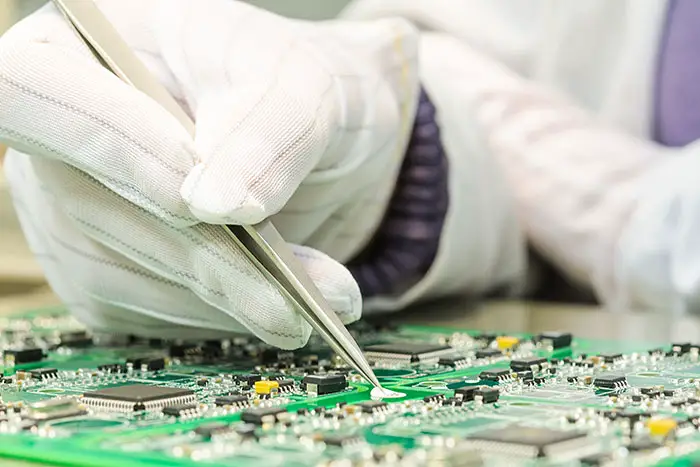Has it ever happened to you that you touched someone’s skin and felt a bit of electricity pass through your hand?
If yes, then this is what we call electrostatic discharge, or ESD in short, which is the release of static energy that builds up in our bodies.
When an electrostatic discharge occurs, the little stream of energy you feel is about 3,500 volts of static energy being released. Anything lower than this, our body doesn’t feel it.

And this is why it is suggested to use ESD-safe gloves while working with static-sensitive devices or components such as computer components or while repairing smartphones.
There is a proper way to clean and wash ESD gloves. First you need to make sure the water is of the right temperature suited for the glove fabric. Also, the cleaning agent should be a non-ionic detergent. And after washing, tumble dry on low heat, or hang dry.
Let us discuss the above mentioned points in detail.
To wash your ESD gloves-
1.) First and foremost, the temperature of the water used to clean anti-static gloves should be suitable. Water temperatures that are too hot or too cold can quickly harm the conductive fibre.
As a result, the water temperature for cleaning anti-static gloves should not exceed 70°C.
-
-
- 60-70°C for polyester fabric,
- 50-60°C for nylon.
-
2.) Before washing the anti-static gloves, clean the surface. The goal of this is to limit dust. Anti-static gloves with oil stains on the surface can be cleaned with a non-ionic liquid detergent before being cleaned in the dust-free cleaning area, and if they are found to be damaged, they must be disposed of.
Check out this non-ionic detergent for cleaning your ESD glove-
Biopharm Triton X-100 Detergent
- CAS 9002-93-1
- 500 ml (16 oz) Plastic Bottle
- Commonly used detergent in laboratories
- High Purity 99%: NOT Diluted
Prices pulled from the Amazon Product Advertising API on:
Product prices and availability are accurate as of the date/time indicated and are subject to change. Any price and availability information displayed on [relevant Amazon Site(s), as applicable] at the time of purchase will apply to the purchase of this product.
1.) The ESD Gloves must be washed on a regular basis to ensure optimal operation. Liquid detergents outperform dry detergents in terms of caking and frictional wear.
2.) When using a typical home machine on the mild cycle, machine washing works effectively. Attempting to wash these gloves in powerful industrial laundry machines is not suggested since it will cause premature wear.
Gloves should be tumble dried on a low heat setting. Remember- do not use bleach.
Okay, so let us understand some of the advantages of using ESD gloves-
1.) First and foremost, it provides good ESD shielding.
2.) There is no dust build-up, effective sweat absorption, and anti-allergenic properties.
3.) Excellent for repairing and working with static-sensitive devices.
4.) The palm and fingers have a non-slip, high grip surface.
5.) It is quite pleasant to wear.
6.) The fit is perfect.
7.) It will keep your electrical components from corroding due to the oils on your fingers and hands.
8.) High-quality, long-lasting materials.
How do these ESD gloves work?
We have 5 pointers here that will let you know how ESD gloves work.
1.) Static dissipative or conductive gloves should be used for ESD protection. They must either conduct or dissipate static electricity. To accomplish this, these gloves are made of a combination of soft synthetic fibres and conductive elements.
This makes the ESD-safe gloves more conductive, preventing static electricity from forming.
2.) When antistatic gloves are worn by someone who works with sensitive, static-prone materials, they can decrease electrostatic charges. These static eliminators work by dissipating static charges without the need of chemicals or treatments.
3.) They are needed while constructing, cleaning, fixing, checking, and replacing pieces of a static-prone product, as well as any other hand-to-product contact with medical equipment, electronics, mobile phones, internal computer components and circuit boards.
4.) All anti-static gloves are reusable and may be cleaned in the same manner as regular gloves. They reduce arcing caused by high conductivity and keep all objects at the same static charge.
5.) Some gloves are constructed of nitrile or a porous material called carbon nylon weave. The palm, inner thumb, and inner finger surfaces of these gloves are sewn with a cut-out of thin antistatic polyvinyl chloride, popularly known as PVC.
These cushions also serve as improved grip material. To limit contamination on the inside and outside of the glove, certain gloves are constructed of latex and treated in a chlorine washing procedure.
So, what are the materials used in the making of ESD gloves?
ESD gloves are available in a variety of shapes and sizes, all of which influence the final function and cost of the glove. These gloves are often composed of the following materials:
1.) Latex is by far the most affordable and widely used material for ESD gloves. However, because of latex allergy, people with sensitive skin should avoid latex.
2.) While vinyl is a good choice for those who are sensitive to latex, it is not as puncture-resistant or as durable as latex.
3.) Nitrile gloves are exceptionally puncture-resistant, long-lasting, and anti-static. They may be used by anyone, regardless of latex sensitivities, because they are composed of synthetic latex. However, nitrile gloves are more costly than vinyl or latex gloves.
Things to remember-
Certain glove materials can be hazardous when used with specific chemicals. For example, while nitrile gloves are robust and do not cause latex allergies, they are not ideal for use with ketone and aromatic solvents.
As a result, your specific work environment may need the use of two or more types of gloves in order to provide the greatest level of protection to both people and goods.
When should you use ESD gloves?
ESD-safe gloves are perfect for all electronic assembly work where skin contact might create issues, such as PC and laptop repair, or where ESD may be a concern.
Even if you are properly grounded, touching an electrostatic discharge (ESD) sensitive gadget might result in a destructive discharge.
One method for slowing and controlling the discharge is to increase the contact resistance of the electrical channel. Wearing ESD gloves is a good approach to do this.
ESD gloves are the ideal gloves to use in a variety of scenarios, including:
-
-
- Construction or repairing of a PC.
- When working with technological devices.
- Workshop for mechanical and electrical work.
- The chemical industry.
- Repair and upgrades for smartphones and other electronic devices.
- Working with gadgets that are static-sensitive.
-
Conclusion
The ultimate purpose of an ESD glove is to reduce static electricity in a certain work environment. ESD gloves should be regarded as a necessary safety equipment in most laboratory, cleanroom, biotech, and electronic work environments.
And since they provide various benefits and protection, we also have to be a little cautious while maintaining them, especially cleaning. There is a specific way these gloves are washed and you need to follow that so that you can reap its benefits for years to come.








